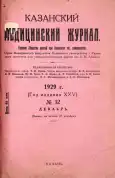Biological method of preventing pregnancy with sperm injections
- Authors: Stolypin F.G.1
-
Affiliations:
- Kovrovskaya railway hospital
- Issue: Vol 25, No 12 (1929)
- Pages: 1296-1300
- Section: Articles
- URL: https://bakhtiniada.ru/kazanmedj/article/view/81034
- DOI: https://doi.org/10.17816/kazmj81034
- ID: 81034
Cite item
Full Text
Abstract
So interesting at the present time, from a practical point of view, the question of sperm immunity was developed at the end of the last century. Already in 1899, Landsteiner, injecting bovine sperm into the abdominal cavity of a guinea pig previously immunized with bovine sperm, observed a rapid cessation of sperm movement and the phenomenon of spermolysis. Mechnikov (1960), injecting human sperm into animals, received substances toxic to spermatozoa in the blood serum of the latter, giving them, for the first time, the name "spermatoxin". Further, by injecting guinea pig spermatoxic serum into a normal rabbit, he received an antispermatoxin. Moxter has established with his research that spermatozoins act only on spermatozoa, without affecting the epithelium of the seminiferous tubules. Metalnikov, injecting the sperm of males into females from guinea pigs, received spermatoxins, which had a devastating effect not only on the spermatozoa of other individuals, but also on their own, that is, they obtained iso-auto-spermatoxins. London, on the basis of his experiments, came to the conclusion that all normal serum has auto-iso-heterospermatoxins, and thus he allowed the existence of physiological spermatoxins. As a result, by the beginning of the twentieth century, enough works on the issue of spermatoxins had already accumulated in the scientific and medical literature. The conclusions of these studies, naturally, prompted experimental work in the field of practical application of sperm immunity.
Keywords
Full Text
##article.viewOnOriginalSite##About the authors
F. G. Stolypin
Kovrovskaya railway hospital
Author for correspondence.
Email: info@eco-vector.com
Head of Department, Obstetric and Gynecological Department
Russian Federation, KovrovReferences
Supplementary files





